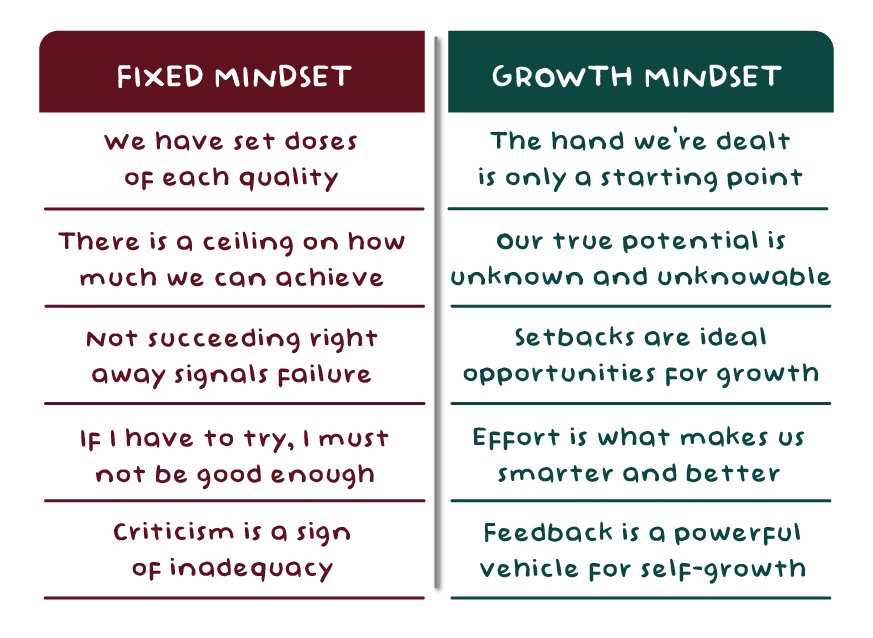Adopting a growth mindset has been instrumental in helping me let go of several unhelpful beliefs. In this post, I’ll describe 5 powerful examples I’m putting to use in my own life.
But first, what is the growth mindset?
In her book Mindset: The New Psychology of Success, Stanford Psychologist Carol Dweck draws a distinction between the fixed and growth mindset. Here’s a cheat sheet summarising the main differences:

Each mindset radically alters how I see life. When I stagnate or stall, an unruly fixed mindset belief is holding me back. When I find myself taking healthy risks, or making consistent progress, the growth mindset is usually spurring me onwards.
- When I see the world through a fixed mindset, the realm of what’s possible starts to contract around me.
- When I see the world with a growth mindset, my horizons begins to expand.
Now we’re on the same page, let’s look at 5 examples of the growth mindset in action.
Stay connected
Sign up below for updates on new content. From time to time, I’ll also share things I’m excited about and projects I’m working on.
1. “I can learn to adopt a growth mindset”
When I first learnt about the growth mindset, I recognised I had been weaving a tangled web of fixed mindset beliefs for a long time. I felt disheartened. How would I ever escape?
Then I realised that believing in my ability to outgrow the fixed mindset is perhaps the most fundamental growth mindset shift of all.
Only once I decided I could work on my beliefs could I then zone in on specific areas to work on.
2. “I’m on a lifelong journey of becoming”
In contrast, the fixed mindset belief would go something like “I’m inadequate” or “I’m not good enough”.
There’s a part of me, still clinging on for dear life, that tells me I’m damaged goods. It believes Oliver Page is deficient down to the core.
But there’s nothing more damaging than the belief that I’m damaged. It implies I am permanently broken. In reality, I am constantly engaged in a dynamic, fluid process of becoming.
I have flaws, but that doesn’t make me broken. I also have strengths, but that doesn’t make me perfect. Generalising one way or the other is severely limiting.
When I allow myself the space to become who I am (which is a lifelong journey), I add richness and excitement to my daily life. The story of my life is perpetually unfolding each and every moment, and I’m the narrator.
“Becoming is better than being. The fixed mindset does not allow people the luxury of becoming. The have to already be.”
3. “I can learn new ways of being and relating”
In contrast, the fixed mindset belief would go something like “my personality is flawed” or “I lack the traits needed for success in work, love and life”.
I don’t believe personality is written in the stars; genetics and upbringing are not our destiny. The relationship we have with our various subpersonalities is dynamic if we choose to engage in dialogue with them.
The word personality comes from the Latin word persona, which means ‘mask’. Early in life, we figure out which masks to pick up. We wear certain masks around friends and other ones around our parents. But as we get older, some of those personas become unhelpful.
As a child, for instance, I created a shy persona to protect myself from rejection. As an adult, this isn’t too helpful for obvious reasons. I still find it hard to open up and get vulnerable around new faces. But with effort and courage, I can transcend the shy part of me.
The growth mindset encourages me to hold the possibility that I can learn new ways of being in relationship, both with my unruly parts and with other people. Genetics and upbringing continue to shape my inborn tendencies, but with a commitment to growth I can begin transcend them.
4. “I always have more to learn”
In contrast, the fixed mindset belief might be “I’ve made it” or “I know everything there is to know”.
Believing I have arrived at some final, static level of knowledge causes stagnation at best, calamity at worst.
When I left medicine and transitioned into medical writing, I had to leave my ego at the door in a big way. I was no longer surrounded by patients who saw me as having all the answers. I had to learn new skills and think on my feet.
To get through, I needed to employ a growth mindset. I reminded myself that it’s okay to feel lost and confused. In fact, those feelings became signs of my humility and openness to learning.
No matter how advanced my knowledge becomes on any subject, I try to approach as if I’m a complete beginner. In Zen Buddhism this is called shoshin, or Beginner’s Mind:
- In the beginner’s mind there are many possibilities, but in the expert’s mind there are few.
5. “I can cultivate a purposeful life”
In contrast, the fixed mindset belief might be: “There isn’t enough purpose or meaning in my life”.
With the fixed mindset, purpose becomes an object to acquire, something I either have or don’t have. But with the growth mindset, purpose is something I can cultivate daily. Like clay, I must mould it continuously by devoting myself to lifelong self-inquiry.
Rather than waiting for inspiration to strike, purpose takes shape when I take responsibility for it. I must commit to moving in a certain direction, and then reflecting on my experiences. What did I enjoy? What makes me come alive? What are my strengths? How do I want to contribute?
These are questions to face on the path towards growth and learning. The alternative is to go with the flow and wait for something to happen, which is emblematic of the fixed mindset.
